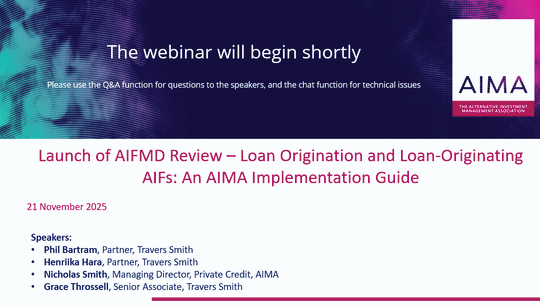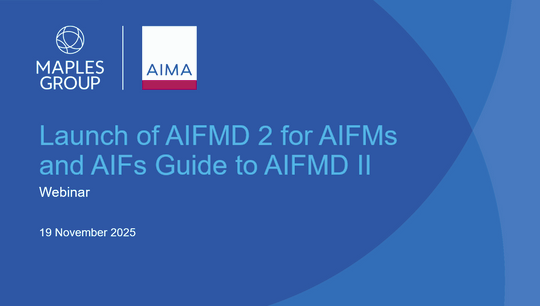MLP stands for ‘managers lead the pack’
By Frances Watson, Partner, Ogier
Published: 14 October 2016
It all started in Luxembourg at the end of 2015 with the proposals for a reserved alternative investment fund (RAIF). Hailed as a game-changer in the Luxembourg fund landscape, RAIFs have responded to the concern that the supervision and regulation of managers introduced by AIFMD was effectively a further (and therefore unnecessary) layer of supervision to funds which were already supervised at the product level.
RAIFs are available for structuring alternative investment funds which appoint duly authorised AIFMs (whether in the EU or third countries when passporting is available) without themselves being subject to regulatory supervision of the Luxembourg supervisory authority, the CSSF.
Then came the Maltese NAIF (notified alternative investment funds framework) which followed a similar pattern of enabling alternative investment funds howsoever structured under Maltese law which appoint full scope AIFMs wherever based and promoted only to eligible investors to come to market simply by notifying the Malta Finance Services Authority.
In May 2016, Guernsey unveiled its Manager Led Product (GMLP) which followed the RAIF and NAIF in terms of focussing on regulation of the manager but broke ranks over the acronym (presumably due to anxiety over sounding too similar to “giraffe”?)
Specifically:
- The GMLP may be used by AIFMs under Guernsey's AIFMD Rules 2013 (Guernsey AIFMD Rules). (The Guernsey AIFMD Rules enable Guernsey AIFMs to opt into an AIFMD equivalent regime to assist the Guernsey AIFM to demonstrate to EU competent authorities compliance with AIFMD for third country passporting purposes.)
- Whilst to make use of the GMLP, Guernsey AIFMs need to be subject to the Guernsey AIFMD Rules, the Guernsey regulator, Guernsey Financial Services Commission (GFSC) has indicated in guidance notes that Guernsey AIFMs may apply for derogations. The ability to derogate from the Guernsey AIFMD Rules is important at the present time because passporting is not yet available. Accordingly, if marketing is taking place in the EU through national private placement regimes then equivalence is not, at present, required and the Guernsey AIFM is able to benefit from not being subject to the full scope of the Guernsey AIFMD Rules.
- However, most significantly, the GMLP applies both to funds of which there is a Guernsey AIFM and associated prospective licensees (e.g. a general partner of a limited partnerships). In the case of a fund, which is ordinarily subject to regulation, it will still be registered by the GFSC but no rules will apply to it. The Guernsey AIFM will notify the GFSC using a prescribed form and the GFSC will register the fund within one business day of receipt of the notification. Managers which are not Guernsey AIFMs (such as a general partner) can be included in the notification to the GFSC for the fund and will be licensed by the GFSC within one business day but no rules will apply to them, enabling regulatory capital to be concentrated at the AIFM level. Accordingly, arguably the GMLP has gone further than both RAIFs and NAIFs in allowing for regulatory efficiencies for managers whilst maintaining legal segregation.
Finally and most recently, a joint consultation exercise by the Jersey Financial Services Commission and the States of Jersey says formal plans for a Jersey registered alternative investment fund will be published by the end of 2016.
Practical implications
In all of its forms, the manager-led product is intended to reduce regulatory duplication which will speed up fund launch, which should translate into a reduction in overall formation costs. With its focus on sophisticated investors and the absence of “tick the box” minimum disclosure requirements it seems that manager-led products will facilitate more flexible constitutional and offering documents. Investor protection is addressed through the regulation of the manager.
Why are the Channel Islands following suit?
The manager-led product provides the optionality which Channel Islands managers, who sit outside of the EU but market both to EU and non-EU investors, need. It sets a framework which is in tune with EU fund regulation and which looks forward to full compliance when the passport is made available but can be used now within the national private placement regime.
However, it can also be used, with derogations, for those managers with entirely non-EU investors, albeit tied to the Guernsey AIFMD Rules. It should be of no surprise that the GFSC has indicated that it is considering developing a further regulatory framework using the same principles but with a discrete set of rules for Guernsey AIFMs marketing to jurisdictions outside of the EU.
But there is more to this than flexibility. The manager-led product has the potential to reduce fund formation cost and, in the form introduced by Guernsey, enables regulatory compliance and capital to be concentrated at the AIFM level, providing ongoing cost savings during the life cycle of a fund, whilst having the potential to address anxiety around substance issues. The future for Channel Islands regulation undoubtedly is now manager-led.







